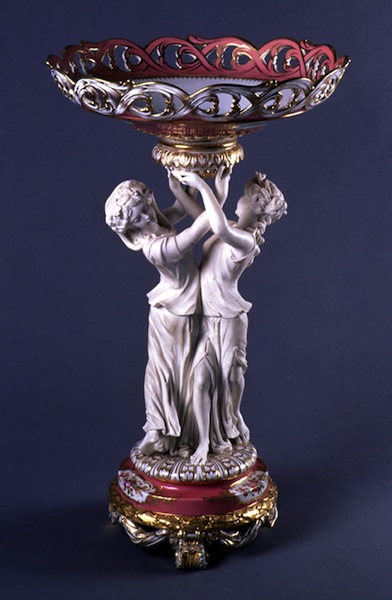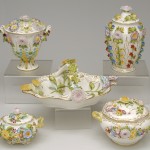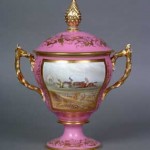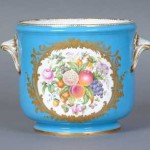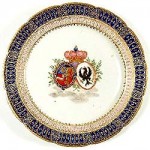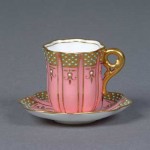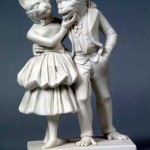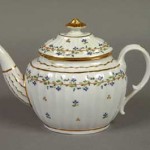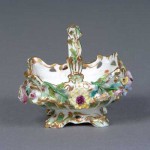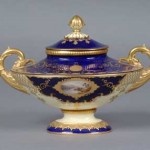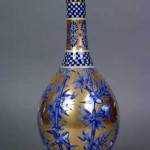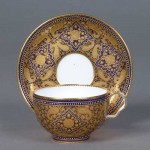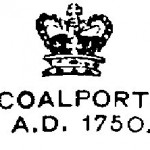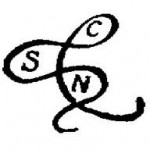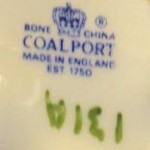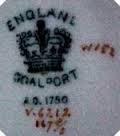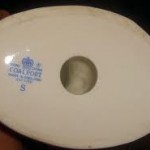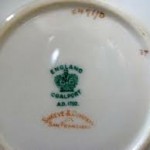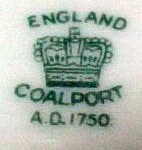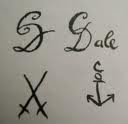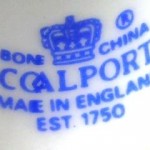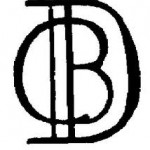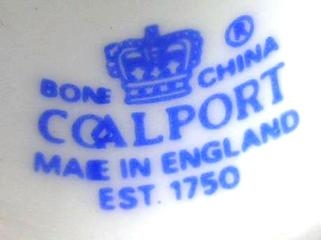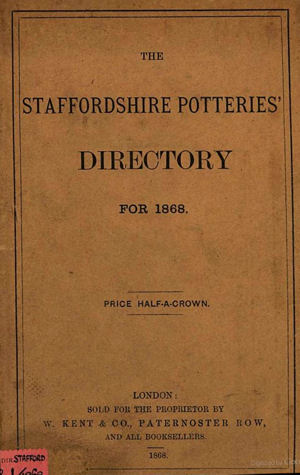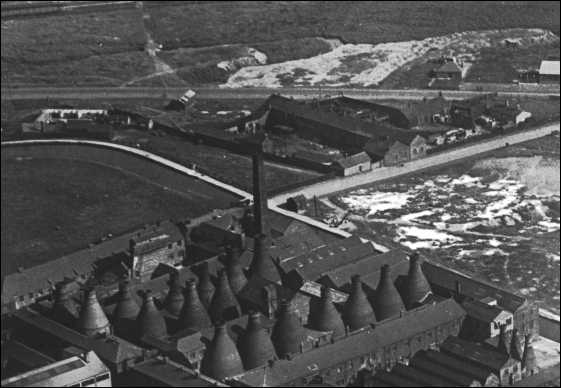- Coalport China Racing Trophy and Cover, Rose du Barry pink ground
- Coalport China Cup and Saucer, jewelled
- Coalport China Pierced Plate, White Cat
- A Coalport Parian figure of cat and monkey in costume c. 1845-1850. Shrewsbury Museums Service.
- Coalport China Basket, Coalbrookdale
- Coalport China Boat-Shaped Vase and Cover, cobalt blue ground
- Coalport China Bottle Vase and Cover, Japanese Grove
- Coalport China Cup and Saucer, Cashmere
- Printed mark, one of several incorporating the name ‘John Rose & Co’ or ‘J.Rose & Co’ Many printed marks also incorporate the initials ‘J R & Co’ or ‘I R & Co’. c. 1830-50
- ‘England’ added to the mark c.1891 ‘Made in England’ replaced ‘England’ from about 1920.
- Printed or gilt ‘ampersand’ mark. c. 1861-1875 The name ‘Coalport’ rarely appears with this mark.
Coalport Porcelain Works
John Rose & Co
Coalport China Ltd
Established at Coalport, Shropshire, by John Rose late in the 18th century.
Later moved to Stoke-on-Trent (see Coalport)
From 1967 part of the Wedgwood Group.
Early pre-1805 porcelains were unmarked and marks were rarely used before 1820.
The early, pre-1820 Coalport wares have proved to be of a type of hard-paste porcelain.
Coalport as a place practically did not exist before it had a porcelain works. Before the Horsehay Company, which supplied Coalport with raw materials, mentioned ‘Coalport’ in its accounts, it was a collection of cottages with a rather nice iron bridge attached! From these small beginnings, pencilled in a Shropshire accounts book, Coalport became a name known the world over for fine quality porcelains, skilled decorators and technical innovation.
During the one hundred and thirty years of Coalport’s active manufacture in Shropshire before transfer to Stoke in the 1920s and eventual absorption into the Wedgwood group, Coalport produced a wide range of styles and shapes. Perhaps the most well known patterns are the ‘Dragon’ pattern, ‘Indian Tree’ and ‘Batwing’.
Coalport’s style developed as the country developed and changed.
In the early years of the nineteenth century, John Rose son of a local farmer and Coalport’s founder, had bought out his brother Thomas and was well on the way towards making Coalport a profitable going concern. In 1820 he bought William Billingsley and Samuel Walker from Swansea and Nantgarw and the styles of decoration during the second quarter of the nineteenth century mirrored closely the porcelains of South Wales.
Table wares marked a revival of the fashionable rococo genre and became closely equated with Coalport and the more flowery rococo productions were soon referred to as ‘Coalbrookdale style’.
John Rose was an innovator and sought constantly to improve the products of his factory until his death in 1841. In 1820 the Society of Arts awarded Rose a Gold Medal for his invention of a new porcelain glaze and body which was thinner and more translucent. . This new ‘feldspathic porcelain’ was easier to handle for the Coalport decorators and modellers alike and by the third quarter of the nineteenth century, such innovations allowed Coalport to indulge in the most elaborate decoration.
A pattern, known as ‘Cashmere’ was first introduced at Coalport around 1873 and highlights the interest in all things oriental at the time. In 1878 the pattern was exhibited at the Paris Exhibition and a service was ordered by the Maharajah of Jaipur.
The opening up of Japan in the 1850s and 1860s and the Meiji Restoration of 1868 led to a craze for Japanese ornament know as ‘Japonesque’. All the Staffordshire factories were soon making Japanese style wares and Coalport was not slow to capitalize on the new fashion. A ‘Japanese Grove’ pattern designed by Thomas Blocksidge is still popular with collectors today.
The later wares of Coalport towards the end of the nineteenth century and into the Edwardian era show Coalport at its decorative height. The finely detailed landscape vases of J.H.Plant, Percy Simpson and Ted Ball show an opulence and confidence that belies the reality as Coalport’s north American market faltered. Orders tailed off after the brief boom in 1919/1920 after the First World War. Perhaps the geographical location itself was to prove unhelpful as Stoke became a stronger potting area and Coalport was so difficult to reach at the end of a branch line.
Today, collectors of Coalport are keen on the cobalt ground landscape vases which featured so heavily in the Edwardian era and also the provenanced and exhibition pieces from the early to middle years of the factory’s existence. In November 2008 for instance, a Coalport porcelain comport, part of a sixty two piece service commissioned by Victoria to commemorate the visit of the Russian tsar Nicholas I in 1844, realised £20,000 at auction.

